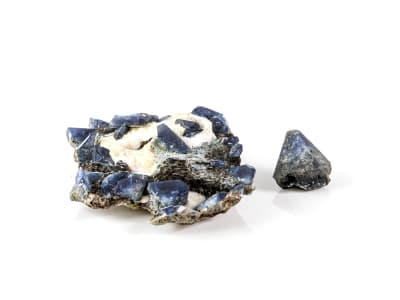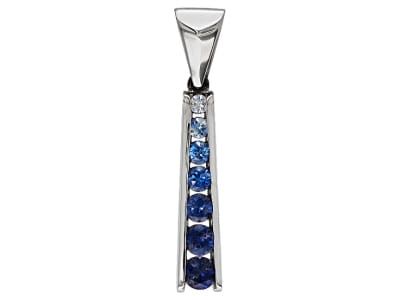The mineral benitoite has been found in only 10 locations around the world. Gem quality benitoite has only been found in San Benito County, California. The Benitoite Gem Mine is the only commercial producer of gem quality benitoite. The mine has only produced approximately 5,000ctw of faceted material over the lifetime of the mine. Only two known gemstones have been cut from the Junnila claim material (Laurs, Rohtert & Gray, 1997). Benitoite was discovered in 1907 by James Marshall Couch and it was named after the San Benito River, the nearby San Benito Mountain, and San Benito County where it is found. Stones are typically below 1ct but stones that range from 1ct to 4ct can be found. The largest stone on record weighed 15.42ct. The ditrigonal-dipyramidal habit is the common crystal occurrence. Stones are colorless, pale blue, blue, and pink naturally. The stones can be heated to produce orange but there is a great danger of stones exploding during the heating process. Stones can have dispersion stronger than diamond and are strongly pleochroic. Due to the high birefringence facet edges will appear to double.
General Information
LWUV: Blue stones inert; colorless to pale blue stones weak red
Benitoite Colors
-
 Blue
Blue -
 Blue
Blue -
 Blue
Blue -
 Colorless
Colorless -
 Pink
Pink -
 White
White
Countries of Origin
Russian Federation; Romania; Unknown; Czechia; Japan; United States of America; Australia
History
Benitoite was discovered in 1907 by James Marshall Couch, a local prospector, near the headwaters of the San Benito River in the mountains of the Diablo Range (Wilson, 2008). The material was first thought to be sapphire, blue obsidian, or spinel. The stones were sent to Davis Louderback, who was an Associate Professor of Geology at the University of California, Berkley, that believed that the material was new mineral species. Louderback raced with George F. Kunz to publish his findings so the new mineral could have a Californian inspired name. Louderback named the mineral benitoite on July 30, 1907. It was named the state gemstone of California in 1985. The Benitoite Gem Mine operated from 1907–2005 under several different names and owners. The Dallas Mining Company actively began mining benitoite in July 1907. Mining ceased 1912 when the mine was deemed not to be profitable. Miller Hotchkiss leased the mine in the 1940’s. Mineral dealer Clarence Cole leased the mine from 1952 to 1967. In 1966 Cole subleased the mine to Gerold Bosley until 1967 when Cole passed away. In 1967 William “Bill” Forrest and Elvis “Buzz” Gray leased the mine until they purchased it in 1987. It was sold in 2005 and operates today as a pay to dig site. The Junnila claim was worked on and off throughout 1982 to 1986 by A. L. McGuinness and Charles Trantham. In 1995 the Kennecott Exploration Company started working the claim. Other bentonite mines are the Mina Numero Uno Claim, Victor Claim, and the Santa Rita Peak Property and (Laurs, Rohtert & Gray, 1997).
Care
Normal, gentle care.


